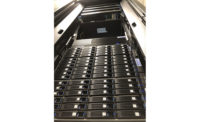Among many factors, there are two main truths that drive the security industry. First, security is critical given that its main function is to protect people, facilities and assets. Second, any disruption in security operations puts these people, places and things at risk. This underscores how important it is for manufacturers and security systems integrators to make sure they are doing everything possible to ensure the reliability of security and surveillance systems.
Today’s networked devices and the ability to connect an ever-expanding number and variety of security and non-security systems have significantly eased the process of monitoring the performance and health of devices and systems. Monitoring networks for health and reliability has been a staple in the IT world for quite a few years, allowing IT staff to quickly identify and address problems that may affect network performance and/or uptime — often before a problem can even occur.
With IP-based video systems more or less becoming the de facto standard for new deployments, the number of components within these systems has grown. These include cameras, recorders, encoders, switches, the network itself and more. A failure of any one of these points could potentially cause a problem, ranging from decreased coverage because a camera has gone down to a disruption in the entire system. In either case, the result is lost video, which not only affects security in the present but can also hinder post-incident investigation in the future.
An unfortunate reality is that in many cases, because live video is not actively monitored, disruptions in video streams are not detected until it’s too late. During an investigation into a specific incident, such as a slip-and-fall claim, for example, security staff may be looking for video from a particular area at a particular time, only to discover that the camera had stopped recording long before the incident. In these cases, a company has no way to determine if a claim is valid or fraudulent.
Instances like this demonstrate just how important video network monitoring and management is to security, and there are a number of providers that have used IT best practices to develop solutions and services designed to address video network performance. Integrators can offer these to their customers as a means of growing revenues, while ensuring that end users get the best possible performance from their video systems.
When talking about video network monitoring, it’s important to be precise about the terms that are used, says Steven Guardini, president of Manasquan, N.J.-based integrator Tritech Associates, because a seemingly simple phrase like “video network” can have very different meanings to different people. Differing perceptions can lead to customer dissatisfaction with the integrator and the service. So those conversations definitely need to occur, Guardini says. (For an in-depth look at the definition of the two most important terms, see “Defining the Terms” on this page.)
The first thing a security integrator must do is to get a grasp on what encompasses a video network and the monitoring and management services that can be provided — and develop a comfort level with communicating these to customers. Next comes selecting a service provider or solution and determining how to price network monitoring and management. Only then is it time to identify potential customers and sell the service. So how do you get started?
1. Selecting a Provider
In general, video network monitoring and management are proactive services that identify technical issues with equipment or systems. In addition to identifying loss of video streams, many solutions also provide early notification of potential problems that may be likely to occur at any point on the network, including cameras, switches, servers, software, etc. This is the true strength of video network monitoring and management solutions, Guardini says.
“Most important is it gives us a proactive response to our clients’ video problems; most of the time we discover and resolve issues before the client even knows there is a problem,” he says.
Carefully evaluating and selecting the network monitoring and management partners is critical. After all, if a provider drops the ball, it’s the integrator who will face consequences with his customer.
Evaluation boils down to two main factors, Guardini says: “Make sure it is a robust multi-vendor platform, and that they have a tech support staff that is responsive.” See “Network Monitoring in Action” on page 102 for an example of the benefit Tritech’s services have provided to one customer.
2. Pricing the Service
Most integrators rely on a service provider to deliver the technology or solution that is used to monitor and manage video networks, a service that is often provided by the vendors themselves. Like traditional alarm monitoring services, this makes pricing the solution to customers very important for integrators.
Normally, these services are delivered primarily as a standalone service for a monthly fee based on the level of monitoring and management and/or additional value-added services a customer selects.
“There is a monthly cost per device to monitor the system, then a fixed monthly fee is charged to proactively monitor the system, which includes a periodic review of the system health and reporting,” says David Sime, vice president of engineering and delivery for Edmonton, Alberta-based Contava. “After-hours response is available for an additional yearly access fee.”
Regardless of how they are priced, Guardini says, the cost of these services is well worth it to end users.
“We price these services in two ways: first, built directly into the maintenance agreements we provide, and secondly, billed as a standalone service,” Guardini explains. “Video network monitoring and management services are relatively inexpensive for what they provide, and can often be bundled into maintenance agreement fees.”
3. Identifying Customers
Once integrators have a provider, services and pricing structure in hand, they are ready to approach customers. Contava has found the most success with customers who have large video deployments. Because these systems are quite complex, the performance of cameras, power systems, networks, computing, storage, software and other factors can potentially impact the health, reliability or usability of the entire system.
“Health monitoring of all these layers enables our people to more quickly diagnose problems,” Sime says.
While this has been a main area of focus for the company, that doesn’t mean video network monitoring is only applicable to these types of customers. Sime says any customer using a VMS that is not capable of providing integrated health monitoring at all of these required levels is prime for these solutions and services.
“This is especially true where we’re deploying the solution on a customer’s shared infrastructure and we need the shortest path to isolating a problem with internal support resources,” he says. For more on the process some of Contava’s customers have taken, see “Why Customers Choose Network Monitoring” on this page.
Tritech offers its network monitoring and management services primarily to customers with which the firm has established maintenance contracts, Guardini says. Among the specific customer types Tritech serves are real estate investment trusts, telecom companies and software companies — all of whom have seen the benefit of discovering disruptions in the network than can lead to missing video as early as possible.
“Clients have been extremely receptive to video network monitoring and management services, especially clients that do not have an active SOC (security operations center),” he says.
Networked video and other security systems have made it possible for integrators to design and deploy more robust, interconnected solutions that provide end users with greater flexibility and security. At the same time, the potential for a device outage to negatively impact the entire system can pose major challenges to maintaining that high level of security.
By taking a methodical approach to these solutions and services, integrators can offer their customers the peace of mind that comes from knowing that their system will be operational and that the video they need will be available if and when they need it.
Why Customers Choose Network Monitoring
Defining the Terms
A potential pitfall a security integrator may encounter when offering video network monitoring services lies not in the technology, but in the terminology, says Tritech Associates’ Steven Guardini. While an integrator may think that “video network” and “monitoring and management” mean one thing, a customer may have a completely different understanding — or no understanding at all — about these terms. It’s important for everyone to be on the same page about video network monitoring from the beginning. To help, he offers definitions for the two most key concepts.
Video network: Much more than simply a network that connects cameras to servers, the video network encompasses the entire infrastructure, including video content management software, video recorders and/or servers, operating systems, storage, networking, camera devices and more.
Monitoring and management: While this is often interpreted as a hardware or software provider’s built-in self-test health check capabilities, it actually encompasses heterogeneous, multi-vendor, multi-application, IT-class capabilities to maintain high levels of system-wide uptime, reliability and integrity.
Why Customers Choose Network Monitoring
While Contava isn’t able to name specific customers, David Sime provided some background and insight into how two of its clients came to use the company’s video network monitoring services.
Large Municipality — “This customer had minimal internal technical capabilities and we needed to provide an objective dashboard and reporting of the overall system health. This not only allowed us to provide better service and allowed the customer to hold us accountable for our service agreement, it also enabled us to use this unbiased data to justify system infrastructure refresh.”
Large Enterprise Client — “This customer had numerous geographically disperse sites with a wide variety of the quality of the WAN infrastructure. The largest benefit to this customer was the historical and real-time data on bandwidth utilization from both the cameras and distributed NVRs. The security department could now use the data to avoid becoming the default culprit in the organization’s WAN infrastructure data consumption problems.”
Network Monitoring in Action
Steven Guardini of Tritech Associates and Contava’s David Sime shared the following stories to illustrate the value of network monitoring and management for end users.
When one of the cameras deployed in a customer’s parking garage stopped recording, Tritech’s video monitoring and management service detected the problem almost immediately. The firm was then able to resolve the issue proactively, even before the end user’s own security staff realized something was wrong, Guardini says. The benefit of this quick action soon became apparent.
“Shortly afterward, a-hit-and-run accident occurred in the field of view of that specific camera, which was successfully recording, so we were able to identify the vehicle,” Guardini says.
Sime says one of the most intriguing customer outage problems Contava has seen was based on performance data. The issue boiled down to the fact that varying motion in the environment under surveillance was causing a 50 percent spike in bitrate during rush-hour periods. Due to video network monitoring and management, Contava was able to identify the culprit and rectify the situation in a timely fashion.
“The key concept we discovered after reviewing performance data combined with user feedback was that the surge in data was completely predictable based on normal traffic patterns for the day and week. However, a special event would cause an abnormal spike and characteristic of the daily throughput activities,” he says. “As such we were able to solve a number of performance problems and better design new solutions in the future.”



